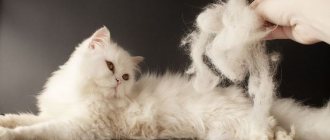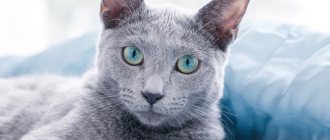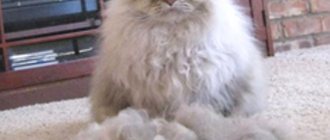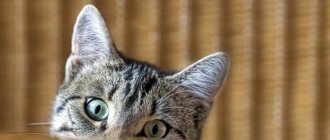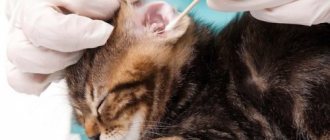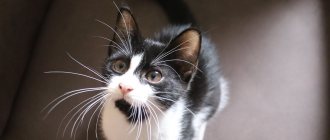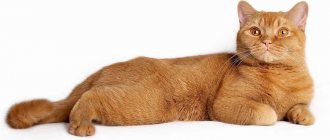All cats shed periodically. For them, this is a natural process of renewing their coat. In such cases there is no cause for concern. But sometimes the hair falls out a lot, which requires taking certain measures.
- Shedding in British breed cats
- Why does a British cat grow hair out of season?
- Prevention
- British cat sheds a lot: what to do
Why does a British cat grow hair?
Shedding in a British or Scottish kitten begins at 4 months and lasts a month. This period is called “adulting”, when the fur becomes coarser and thicker.
British cats shed twice a year, in spring and autumn. If the fur comes out in winter or summer, there is no need to panic, because the British and Scots have dense fur, and shedding does not always depend on the season. A change in coat can be caused by the following reasons:
- Allergic reaction to dry food, household chemicals, pollen from growing plants, dust, perfumes.
- Stressful situations. British cats are not stress-resistant; for them, even moving their food bowl is stressful.
- Lack of vitamins in the diet. With a lack of vitamins, the entire body suffers, the hair becomes fragile and prone to loss.
- Poor nutrition. Scots, Britons and other cat breeds should have a balanced diet.
- Childbirth. The offspring takes in a lot of nutrients; it is important to give the cat vitamins during the prenatal period.
- The presence of fungus and other skin diseases.
- Hormonal changes in the body. For example, in Scottish boys, a failure may occur due to the absence or disruption of mating phases.
- Frequent washing. You should bathe your pet only when necessary.
What to do if your British cat sheds a lot
In order to shorten the shedding period of a British cat, veterinary experts recommend using the following methods:
- Switch your pet to high-quality food and ensure your pet receives the necessary vitamins and microelements.
- In the autumn, reduce daylight hours for your pet - there is no need to leave your British cat in a lighted room in the evenings.
- Do not let the animal sleep on radiators or in other warm places. Be sure to ventilate the room at night.
- The air in the room where the cat is kept should not be dry.
In any case, such measures will help the molt proceed without complications and provide the animal with the greatest comfort.
Important! Any deviation from the norm during shedding or the formation of bald patches as a result of excessive hair shedding is a reason for an urgent visit to a specialized veterinary clinic.
Grooming
Regular brushing of fur during shedding is necessary not only to reduce soiling of carpets and sofas. This process is extremely important for the health of the British:
- during combing, the skin in the growth zone of the root bulbs is massaged;
- metabolism improves;
- the undercoat layer is ventilated.
If a cat is accustomed to brushing and does not panic at the sight of a brush, it enjoys it and its health improves.
Important! You should not bathe your British cat while shedding. This disrupts the natural balance of substances, changes the acid-base level and can prolong the period of hair loss.
Antiparasitic treatments
A mandatory procedure for British breed cats is annual vaccination and treatment against parasites (external and internal). These measures do not directly affect the molting process, but they improve health, prevent the development of a number of diseases and are always considered in conjunction with other preventive measures.
If a small British kitten sheds heavily, then first of all you need to ask whether its mother has been treated for worms, fleas and lice. Most often, at an early age, they become the cause of active shedding of fur.
Changing the indoor microclimate
The living conditions of a British cat affect how the pet sheds. In this sense, everything must be done to ensure that the animal experiences at least minimal changes in temperature and humidity, since the body is guided by the length of daylight hours and the accompanying climatic conditions.
The cat owner must:
- regularly ventilate the room;
- provide walks on the street or at least equip a place for the cat on the balcony;
- maintain an appropriate level of humidity in the house/apartment - dry air completely changes the structure of the hair and the molting cycle.
It is necessary to provide the animal with the opportunity to climb to high places and settle down there. Even within the same room, but at different levels, temperature and humidity change, and the cat itself finds the most comfortable place.
Reducing stress levels
The most common cause of stress for a British cat is noisy company in the house and lack of privacy. The breed prefers solitude rather than constant communication. Failure to comply with this condition leads to increased emotional stress, which can result in aggression or lead to the onset of prolonged molting. Once the source of the irritation is eliminated, your Briton will be at peace and will return to his normal coat changing routine.
How long does the seasonal coat change last?
This phenomenon is usually observed in animals in autumn and spring.
If a Scottish Fold or British cat sheds a lot during the season, this is normal. Shedding periods:
- Spring. A kitten or adult pet sheds its fur for the summer, and the downy undercoat goes away.
- Autumn. Scottish cats gain fluff to keep warm; in summer, indoors are cooler than outdoors.
However, if a British domestic cat did not change her fur in the spring, but did it in the summer, this is also normal, since domestic cats grow hair in different seasons, throughout the year. The shedding period ranges from 2 weeks to 2 months; if longer, you need to consult a veterinarian to find out the causative factor.
What to pay attention to
In addition, in British cats, shedding is caused by internal disturbances in the functioning of the body. At the slightest suspicion, you should also go to a veterinary clinic in order to, if possible, prevent or cure all diseases in the early stages.
If your British cat is shedding, don’t panic and immediately run to the doctor; the problem can be easily solved at home. Your cat’s healthy coat is the key to its impeccable health and the owner’s endless love for his pet.
Symptoms of Unhealthy Shedding
The quality of the fur of British breed cats must always be monitored; this is very important, because cats can lose their fur not only during the season, but also due to diseases that may be caused by internal disorders in the functioning of the body. If a fold-eared cat often sheds hair from certain areas, and the process is accompanied by itching, this is a sign that the pet has a fungus (ringworm). If you experience these symptoms of unhealthy shedding, you should contact your veterinarian. Also, if there is a lack of vitamins or improper nutrition, the animal may develop dermatitis, skin irritation, which leads to hair loss. In such cases, it is worth changing the food and monitoring the cat’s reaction.
Your pet is shedding - it doesn't hurt to be careful
In addition to the reasons already mentioned that provoke molting in a cat, more serious events may also occur.
However, in most cases there is no reason for this, since in winter a British cat receives less vitamins, warmth and care. This is what causes the British cat to begin to actively shed.
In addition, you can name several more reasons when a pet sheds:
- stressful situations: in most cases this is associated with moving, undergoing operations or long-term illnesses;
- childbirth: in addition to the fact that the pregnancy process itself takes away strength, babies take almost all the nutrients from the mother, as a result of which she begins to shed;
- poor nutrition: cats react very sensitively to the slightest changes in their tiny bodies, so a healthy diet is very important;
- allergic reactions: most often occurs due to the British intolerance to certain types of dry food;
- hormonal surges: especially noticeable in breastfeeding women after childbirth;
- the presence of fungi and diseases.
What to do: how to reduce the amount of hair loss?
If there are signs of unhealthy shedding, there is no need to self-medicate; you need to seek help from specialists.
Sometimes cutting the animal helps solve the problem.
If a Scots sheds during the season, during this period the following rules for caring for your pet should be followed:
- brush the fur daily with a brush and massage movements;
- bathe the cat using a special shampoo;
- trim the animal to reduce the amount of hair falling out;
- ventilate your home, this helps reduce the concentration of cat hair in the air;
- provide your pet with a balanced diet enriched with vitamins;
- eliminate all possible stress factors.
By adhering to simple rules, you can significantly reduce the amount of wool throughout the apartment and on upholstered furniture, and prevent the development of an allergic reaction in the owner. You can also prevent unwanted diseases in your British cat, because when licking the cat’s fur, the cat swallows hairs that form a hairball in the stomach, causing indigestion and other internal problems.
Basic Rules
It is possible to alleviate the suffering when a British cat sheds heavily, but it is not always possible to observe all the necessary points. To avoid allergies among family and visitors to your home, regularly ventilate the room and clean it.
Special shampoos will also help you, somewhat reducing hair loss and making the process when the animal sheds less noticeable and painful.
However, there are times when the best solution would be to seek advice and help from a veterinarian. For example, if you notice hair loss only in certain places on the body of a British cat, and the hair itself falls out unevenly in clumps, immediate treatment is necessary. Often these symptoms are caused by infections of microsporia and trichophytosis, or ringworm. Such diseases are dangerous both for the pet itself and for the owners.
What to do if your cat is severely bald
The problem with hair loss in a pet manifests itself very clearly - tufts of fur scatter throughout all rooms, small hairs stick to clothes and fleecy furniture. To make a diagnosis, you should first pay attention to the behavior of the pussy. If the animal remains active and cheerful and does not suffer from loss of appetite, most likely the cat is simply experiencing seasonal shedding.
Reasons to consult a doctor may be:
- Changes in the cat's behavior: aggressiveness, apathy, constant need to lick or scratch.
- Uneven hair loss, appearance of bald patches on the body.
- The appearance of blisters, redness of the skin, and the formation of keratinized scales.
- Light or black dandruff.
A visit to the doctor should not be postponed. Losing clumps of hair in a cat is not just a cosmetic problem. The cause of this phenomenon can be a serious health problem, even malignant neoplasms in the animal’s body. After conducting a full examination, taking skin and blood samples for analysis, the veterinarian will be able to make a diagnosis and determine therapeutic methods.
In case of atopic dermatitis, the animal will be prescribed strict adherence to a special diet; in case of allergies, antihistamines will be prescribed; in case of parasitic infection, measures should be taken to disinfect the cat’s body.
In less serious cases, a set of simple measures will be sufficient to restore the animal’s normal condition:
- Correcting the cat’s diet, adding foods necessary for health to the food.
- Regular hygiene procedures.
- Pet vaccination.
- Carrying out vitamin therapy.
- Creating a favorable psychological microclimate for your pet.
Appearance care
Complete care for the appearance of a British chinchilla consists of several activities that should be carried out strictly.
Combing
The coat of golden chinchillas includes guard hair and undercoat. Such a multi-level cover needs careful care. Combing is carried out first in the direction of hair growth, and then against the grain. This procedure is performed twice a week, using a special glove or a fine-toothed comb.
Bathing
Despite the fact that the coat of golden chinchillas is quite light, it does not get dirty very often. Therefore, there is no need to bathe your pet often - once every 3 months is enough.
For washing, special shampoos and softening conditioners are used. If there is an urgent need, you can use dry products for washing cat fur, which are selected taking into account the color of the pet.
Ear care
Chinchillas' hearing organs should be carefully examined every 2 weeks. Ear care involves removing dirt and dark plaque using cotton wool. The latter should be moistened with a special composition intended for caring for the ears of cats.
Eye care
The visual organs of British chinchillas require careful care, as they tend to bleed profusely. This process is explained by the original structure of the animal’s tear ducts.
Pets' eyes should be examined regularly to prevent clots from accumulating in the corners. Every morning, the animal’s eyes are wiped with a cotton pad soaked in a solution of boric acid, warm boiled water or a decoction of herbs.
If suppuration is observed, it is permissible to use tetracycline ointment. Progressive eye pathologies require immediate attention to a veterinarian.
Nail care
The claws of golden cats are trimmed once every 2-3 weeks, using special scissors called nail clippers. The pet can remove keratinized particles themselves using a scratching post installed in the room. The latter must be stable and securely fastened.
Health
Health problems can also cause shedding. Changes in hormonal levels can lead to hair loss. Cats shed hair after giving birth, and this is normal. But changes can also be caused by the proximity of an animal of a different sex. Even if the prospective partner lives in the next doorway, the cat can smell him. Inability to satisfy the sexual instinct or, conversely, exhaustion from frequent mating or childbirth can cause molting. Veterinarians recommend sterilizing animals not intended for breeding. This avoids hormonal surges and reduces the likelihood of tumor diseases.
Shedding can also be caused by various diseases. Severe hair loss can be an alarming symptom along with an unpleasant odor from the mouth, coughing, scratching, lethargy, etc. A veterinarian should figure out what the pet is sick with and prescribe treatment. Shedding caused by the disease will only go away after the animal has recovered.
Reasons for the British dog's shedding
If a British cat has a lot of hair coming out, this is a reason to pay attention to the situation and think about why this could happen. In some cases, the reasons are so trivial that they do not even deserve attention. We can talk about high air temperature in the apartment in winter or poor combing . In this case, by removing the provoking factors, it will be possible to solve the problem. True, sometimes the situation requires the intervention and attention of the owners.
Seasonal molt
The British cat sheds heavily several times a year.
Namely:
- Before the onset of heat (spring). The daily rising temperature indicates to the body that hot days are coming soon, so it’s time to get rid of the winter coat. Consequently, the undercoat comes out, and along with it the long hair falls out, being replaced by short and thin pile.
- Before the cold season. A gradual decrease in daylight hours, as well as a decrease in temperatures (especially at night) is a signal for the body that it is time to change the cat’s thin coat to a dense one. At the same time, for this to happen, the fine fur must fall out, and in its place a thick and furry undercoat will appear.
Important! Britons who have access to the outdoors shed the heaviest. They are very sensitive to weather changes, which affects their appearance.
Hair loss also occurs in pets, but in this case the seasonality may be somewhat washed away. That is, some cats shed not in October, when it starts to get colder, but in December or even January. The same applies to summer. The natural process shifts a little, but there is nothing strange or scary about it. In any case, molting always makes itself felt twice a year.
The history of the British chinchilla
The history of the origin of British golden chinchillas still causes a lot of controversy. There are several versions of the origin of these animals. According to the first of them, the ancestors of the chinchilla were brought to Britain from Ancient Rome. Followers of this theory are confident that the British are representatives of ancient cat breeds.
However, another part of the researchers is confident that golden chinchilla cats were bred by crossing with other breeds. Such selection work was carried out directly by English researchers. It is believed that the chinchilla owes its thick coat of beautiful color to the crossing of smoky British cats and Persian-colored cats.
This is interesting. Due to the fact that the British chinchilla was created by crossing short-haired and Persian cats, long-haired kittens can be found in the litter. However, the British Longhair cat must meet the same standards as the British Chinchilla.
Gradually, breeders continued crossing, diluting the new breed with the blood of Tabby cats. Experts managed to obtain a golden color using the method described above. But the basis for genetic experiments was no longer Tabby, but a new breed - the magnificent silver chinchilla.
Causes and solutions to problems: season
A fluffy little ball brings a lot of happiness and no less trouble. One of the constant headaches for a clean housewife is shedding in cats. In normal times, if a pet loses fur, it is only a little. During the molting period, some cats are able to cover their apartment furnishings with down.
When do kittens start moulting?
Cats start shedding early. At about the age of six months, kittens begin to gradually change not only the structure, but the color of their fur. The duration of the first moult varies. Sometimes at least 6 months. During this time, the kitten sheds baby fluff, growing dense guard hairs. In point and multi-colored cats, the markings appear brighter. The appearance becomes complete.
You need to combat molting in a comprehensive manner. To begin with, support the kittens with vitamins and enhanced nutrition. In addition, this is a good opportunity to accustom your pet to hygiene procedures: combing and bathing. And simply smoothing your fur coat with a damp hand will not only be pleasant, but also useful.
Don't miss this moment: how well you take care of your kitten will determine the appearance of an adult cat in the future.
Why and how cats shed
Subsequently, molting will become regular. For cats, this is a natural process of preparing for the change of season. Ideally, a cat sheds twice a year:
- before the cold weather begins. Reducing daylight hours and a significant decrease in temperatures include protective mechanisms that involve a change in wardrobe. Cats are rapidly growing a new coat that can protect them from frost. For example, the British grow a powerful, dense undercoat, which is much thicker than the summer one;
- before the onset of heat. Rising temperatures make it necessary to prepare for the summer heat. “Winter” fur, having served its purpose, is no longer needed. Therefore, a lightweight version is growing.
Cats that have free range react most strongly to the change of seasons. Their bodies are exposed to natural weather conditions and are sensitive to the changing seasons.
Cats living in an apartment without walking, despite the lack of seasonality in the home climate, also shed. Only the time of this process is not strictly tied to the environment. Depending on the breed, cats shed 1-2 times a year.
It should be borne in mind that in mature, uncastrated cats, shedding can begin at any time as a reaction to certain changes in physiology. This is how the body will react to hormonal changes during estrus or after kittens are weaned from mother's milk. This is not a reason to panic, you just need to provide your cat with improved nutrition and vitamins.
How long does seasonal molting last?
If you are scared by your kitten's long first molt, don't worry. This is due to complex processes of physiological maturation. Shedding in cats that can be called adults goes back to normal. On average it lasts a couple of months a year. Once in the spring, and again at the end of autumn. There may be minor time shifts in the schedule.
Usually short-haired pets fit into the schedule and timing of shedding. It’s more difficult with the fluffier ones. Persians or Maine Coons, after shedding their guard hairs, take a long time to get rid of the undercoat. They definitely won't be able to do it without your help. If you don't help them with their struggle, the consequences can be serious. From local tangles to completely matted fur.
Sometimes shedding in cats occurs unplanned or does not stop for a long time.
Reasons for intense year-round shedding
Considering that shedding in cats is a natural physiological process, it is important to understand when it goes beyond the normal. If fur falls out intensively for more than a month, especially out of season, and without objective prerequisites, this is a reason to think about the reasons for what is happening.
Usually a cat sheds a lot:
- During illness. It doesn't matter if there is an internal disease or the cause is on the surface of the body, shedding in cats is an indicator of health. In normal condition, fluff does not fly in different directions. Moreover, you can suspect anything: from banal vitamin deficiency or allergies to serious diseases of internal organs. Only specialists will carry out competent diagnostics. You should not self-medicate, as you will only make the problems worse.
- Unsuitable care products. If health is not suspicious: tests are normal, behavior is active, and shedding does not stop, this is a reason to change the shampoo, at a minimum. Ideally, change all cosmetics for the cat. You may be using the wrong brush. Pay attention to what accessories are recommended by breeders and veterinarians for each specific breed separately for everyday care and for the molting period.
- Errors in feeding. Often the reasons for year-round molting are in the food. Natural food must be prepared according to special recipes that provide an ideal balance of nutrients. Be sure to supplement with vitamin supplements a couple of times a year. Ready-made food, even the most expensive and high-quality, is also not a guarantee of peace of mind. One ingredient that is individually unacceptable to your cat and shedding is guaranteed all year round. Choose carefully. Preferably, with control through analysis.
- Stress. Among cats there are phlegmatic cats that hardly react to changes in the external environment. But there are cats for whom even your daily trips to work become the real end of the world. Jealousy, lack of attention, loud noises, unfamiliar smells - this world is fraught with many dangers and possible causes for stress for cats. If diseases are excluded, feeding and accessories are checked to the smallest detail, go to the veterinarian for a sedative.
Sometimes a cat sheds heavily in winter, especially if it constantly lives within four walls. Among the reasons: dry air and too high a temperature. How to fight? Humidifiers. Open containers of water that evaporate moisture help a lot. For example, an aquarium. Again, fun for the cat.
Methods for reducing fur during shedding
When a cat sheds, you will need a whole arsenal of tools to fight it:
- Complete balanced nutrition.
- Supplements and vitamins. Particular emphasis on amino acids. Along with veterinary supplements, you can give an egg yolk and be sure to leave the sprouted grass. For long-haired dogs, it makes sense to buy a paste to remove lumps from the digestive system.
- Give the cat a bath. With water and subsequent combing, the lion's share of dead hairs is eliminated.
- Combing. Cats with short fur without a lot of undercoat will get by with a regular brush a couple of times a week. For furry cats or cats with thick undercoat, you may have to resort to a furminator.

